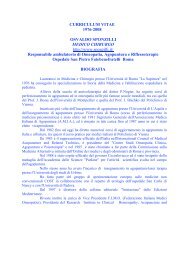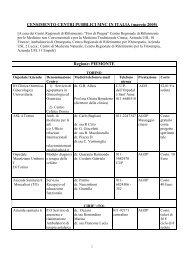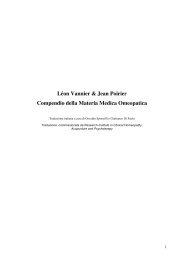Luce LED Nuove prospettive in medicina estetica - Sponzilli.it
Luce LED Nuove prospettive in medicina estetica - Sponzilli.it
Luce LED Nuove prospettive in medicina estetica - Sponzilli.it
You also want an ePaper? Increase the reach of your titles
YUMPU automatically turns print PDFs into web optimized ePapers that Google loves.
Tecnologia<br />
Sorgenti di luce non coerente<br />
La fotobiomodulazione è stata così effettuata:<br />
■■<br />
tecnologia pulsata 800 on e 100 off;<br />
■■<br />
lunghezze d’onda 660 e 850 nm;<br />
■■<br />
tempo di trattamento 3 m<strong>in</strong>uti a 660 nm e 3 m<strong>in</strong>uti a 850 nm;<br />
■■<br />
sedute effettuate 12, con frequenza 2 volte a settimana.<br />
Il risultato è stato verificato <strong>in</strong> term<strong>in</strong>i di pH, elastic<strong>it</strong>à cutanea e <strong>in</strong>dice di soddisfacimento<br />
<strong>in</strong>dividuale a 2 mesi e a 4 mesi. L’elastic<strong>it</strong>à cutanea è migliorata nella media del gruppo esam<strong>in</strong>ato<br />
del 24%, mentre l’<strong>in</strong>dice medio di soddisfacimento per un miglioramento generale dello stato<br />
della cute e riduzione di rughe sottili è risultato 7 <strong>in</strong> una scala da 1 a 10 (figura 1).<br />
Questi risultati ci hanno portato a <strong>in</strong>traprendere un nuovo lavoro che oltre a sfruttare l’effetto di<br />
fotobiomodulazione utilizzi anche la fotoporazione, per cui abbiamo <strong>in</strong>iziato una sperimentazione<br />
fotoporando preparati idrolizzati di fibronect<strong>in</strong>a, sieri proteici ed epigallocatech<strong>in</strong>gallato al f<strong>in</strong>e<br />
di verificare l’effetto comb<strong>in</strong>ato di fotoporazione e fotobiomodulazione. Essendo però questa<br />
sperimentazione ancora all’<strong>in</strong>izio non siamo <strong>in</strong> grado di poter trarre nessuna conclusione anche se<br />
i risultati sembrano estremamente <strong>in</strong>coraggianti.<br />
Trattamento dell’acne<br />
L’effetto della luce <strong>LED</strong> si esplica soprattutto nel dim<strong>in</strong>uire la popolazione batterica e<br />
nell’elim<strong>in</strong>are la flogosi. Il Propionibacterium acnes è il microrganismo prevalente nella pelle e nei<br />
follicoli delle aree ricche <strong>in</strong> ghiandole sebacee; questo batterio produce porfir<strong>in</strong>e endogene la<br />
cui componente pr<strong>in</strong>cipale è la coproporfir<strong>in</strong>a 3. L’esposizione alla lunghezza d’onda del blu e<br />
del violetto aumenta la produzione di questa porfir<strong>in</strong>a attraverso l’assorbimento di fotoni e la<br />
Bibliografia<br />
1. Cornelius CE III, Ludwig GD. Red fluorescence of comedones:<br />
Production of porphyr<strong>in</strong>s by Corynebacterium acnes. J Invest Dermatol<br />
1967; 49: 368-370.<br />
2. Elman M, Lebzelter J. Light therapy <strong>in</strong> the treatment of acne vulgaris.<br />
Dermatol Surg 2004;30:139-146.<br />
3. Elman M, Slatk<strong>in</strong>e M, Harth Y. The effective treatment of acne vulgaris<br />
by a high-<strong>in</strong>tens<strong>it</strong>y, narrow band 405–420 nm light source. J Cosmet<br />
Laser Ther 2003; 5: 111-116.<br />
4. Iuchi S; Chen H; Paesani F; Voth GA. Hydrated excess proton at waterhydrophobic<br />
<strong>in</strong>terfaces. J Phys Chem B 2009, 113: 4017-4030.<br />
5. Karu T. Primary and secondary mechanisms of action of visible to near-<br />
IR radiation on cells. J Photochem Photobiol B 1999; 49: 1-17.<br />
6. Karu TI. Photobiological fundamentals of low-power laser therapy. J<br />
Quantum Electron 1987; 23: 1703-1717.<br />
7. Kawada A, Aragane Y, Kameyama H, et al. Acne phototherapy w<strong>it</strong>h a<br />
high-<strong>in</strong>tens<strong>it</strong>y, enhanced narrowband, blue light source: An open study<br />
and <strong>in</strong> v<strong>it</strong>ro <strong>in</strong>vestigation. J Dermatol Sci 2002; 30: 129-135.<br />
8. Kjeldstad B, Johnsson A. An action spectrum for blue and near<br />
ultraviolet <strong>in</strong>activation of Propionibacterium acnes; w<strong>it</strong>h emphasis on a<br />
possible porphyr<strong>in</strong> photosens<strong>it</strong>ization. Photochem Photobiol 1986; 43:<br />
67-70.<br />
9. Kligman L.H., Photoag<strong>in</strong>g. Manifestations, prevention, and treatment,<br />
Cl<strong>in</strong>. Geriatr. Med. 5 (1989) 235–251.<br />
10. Leyden JJ. Therapy for acne vulgaris. N Engl J Med 1997; 336: 1156-<br />
1162.<br />
11. Pratesi R, Sacchi CA. Lasers <strong>in</strong> Phoromedic<strong>in</strong>e and Photobiology, dalla<br />
collana “Spr<strong>in</strong>ger Series <strong>in</strong> Optical Sciences”, Spr<strong>in</strong>ger-Verlag, Berl<strong>in</strong>,<br />
1980.<br />
12. Russell BA, Kellett N, Reilly LR. A study to determ<strong>in</strong>e the efficacy of<br />
comb<strong>in</strong>ation <strong>LED</strong> light therapy (633 nm and <strong>in</strong> facial sk<strong>in</strong> rejuvenation.<br />
J Cosmet Laser Ther 2005; 7: 196-200.<br />
13. Sch<strong>in</strong>dl A, Sch<strong>in</strong>dl M, Scho’n H, et al. Low-<strong>in</strong>tens<strong>it</strong>y laser irradiation<br />
improves sk<strong>in</strong> circulation <strong>in</strong> patients w<strong>it</strong>h diabetic microangiopathy.<br />
Diabetes Care 1998; 21: 580-584.<br />
14. Sigurdsson V, Knulst AC, van Weelden H. Phototherapy of acne vulgaris<br />
w<strong>it</strong>h visible light. Dermatology 1997; 194: 256-60.<br />
15. <strong>Sponzilli</strong> O. Cromopuntura: Applicazioni Pratiche (Video). VBM Picture<br />
Trevignano R. (RM), 1998.<br />
16. <strong>Sponzilli</strong> O. Iniziazione alla Cromoterapia. Med<strong>it</strong>erranee, Roma 1998.<br />
17. <strong>Sponzilli</strong> O. Organoterapia, auricoloterapia e cromoterapia frequenziale<br />
<strong>in</strong> medic<strong>in</strong>a anti-ag<strong>in</strong>g: lo stato dell’arte. 10° congresso Univers<strong>it</strong>ario di<br />
Medic<strong>in</strong>a <strong>estetica</strong> e Medic<strong>in</strong>a Naturale. Univers<strong>it</strong>à Tor Vergata Roma<br />
19-07-2011.<br />
18. <strong>Sponzilli</strong> O. Le stimolazioni frequenziali <strong>in</strong> medic<strong>in</strong>a. Auricoloterapia.<br />
Tecniche <strong>Nuove</strong>, Milano 2012.<br />
19. Stadler R, Orfanos CE. Maturation and ag<strong>in</strong>g of elastic fibers. Arch<br />
Dermatol Res 1978; 262: 97–111.<br />
20. Tzung TY, Wu KH, Huang ML. Blue light phototherapy <strong>in</strong> the treatment<br />
of acne. Photodermatol Photoimmunol Photomed 2004; 20: 266-269.<br />
21. Whelan HT, Connelly JF, Hodgson BD, et al. NASA light-em<strong>it</strong>t<strong>in</strong>g diodes<br />
for the prevention of oral mucos<strong>it</strong>is <strong>in</strong> pediatric bone marrow transplant<br />
patients. J Cl<strong>in</strong> Laser Med Surg 2002; 20: 319-324.<br />
22. Whelan HT, Sm<strong>it</strong>s RL, Jr., Buchman EV, et al. Effect of NASA lightem<strong>it</strong>t<strong>in</strong>g<br />
diode irradiation on wound heal<strong>in</strong>g. J Cl<strong>in</strong> Laser Med Surg<br />
2001; 19: 305-314.<br />
23. Barolet D. Light-Em<strong>it</strong>t<strong>in</strong>g Diodes (<strong>LED</strong>s) <strong>in</strong> Dermatology. Semim<strong>in</strong>ars <strong>in</strong><br />
Cutaneous Medic<strong>in</strong>e and Surgery. 2008; 27(4): 227-238.<br />
24. Weiss RA, McDaniel DH, Geronemus R, et al. Cl<strong>in</strong>ical trial of a novel<br />
non-thermal <strong>LED</strong> array for reversal of photoag<strong>in</strong>g: Cl<strong>in</strong>ical histology, and<br />
susface profilometric results. Laser Surg Med 2005; 36: 85-91.<br />
25. Meirelles GC, Santos JN, Chagas PO, et al. A comparatice study of<br />
effects of laser photobiomodulation on the heal<strong>in</strong>g of third-degree<br />
burns: Photomed Laser Surg 2008; 26: 159-166.<br />
26. Barolet D, Boucher A, Bjerr<strong>in</strong>g P. In vivo human dermal collagen<br />
production follow<strong>in</strong>g <strong>LED</strong>-based therapy: The importance of treatment<br />
parameters. Lasers Surg Med 2005; 17: 76.<br />
27. Lee S.Y., Park K.H., Choi J.W, et al. A prospective, randomized,<br />
placebo-controlled, double-bl<strong>in</strong>ded, and spl<strong>it</strong>-face cl<strong>in</strong>ical study on <strong>LED</strong><br />
phototherapy for sk<strong>in</strong> rejuvenation: Cl<strong>in</strong>ical, profilometric, histology,<br />
ultrastructural, and biochemical evaluations and comparison or three<br />
different treatnent sett<strong>in</strong>g. J Photochem Photobiol B 2007; 27:<br />
51-67.<br />
46 Dermakos • maggio 2012






